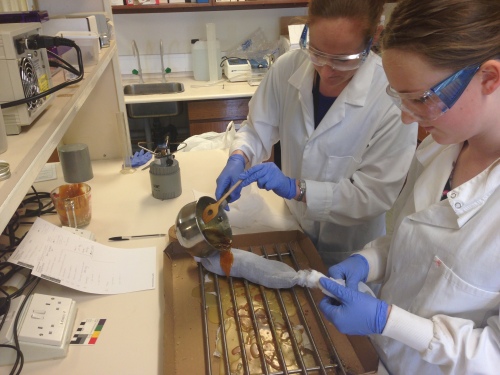https://egyptmanchester.wordpress.com/2015/10/05/animal-mummies-6-making-experimental-mummies-in-manchester/
Animal Mummies #6: Making experimental mummies in Manchester
Part of the research for the Ancient Egyptian Animal Bio Bank project involves assessing whether it is possible to make modern experimental animal mummies in Manchester. Previous attempts at mummifying animals have used species not known from the votive mummy record and many have used techniques that are commonly witnessed in human mummies, rather than animals. This means that the experiments are not reliable indicators through which to investigate the mummification of votive animals.The subjects for these experiments are a mixture of birds donated to the Natural History Museum in Tring, including Sparrowhawks, Kestrels and Buzzards. All of these species have been identified in mummies. Other candidates include rodents, passerines and snakes.
As no ‘recipe’ for votive animal mummification has been found from ancient Egypt, chemical analysis from samples has identified combinations of tree resins, beeswax and animal fat (Buckley et al. 2004; Brettell et al. forthcoming). This resinous substance is often visible on radiographs as a radiodense layer close to the animal body or as patches throughout the wrapping layers.
Radiographic analysis of animal mummies has shown that in many cases the internal organs remain in situ indicating that evisceration was not always practiced. Mummies which show no internal contents cannot be taken as evidence of evisceration, as the small body sizes and the effects of the desiccation process can mean that they are present, but not visible radiographically. Only two mummies in the 330 studied so far for the project have revealed evidence for abdominal packing, showing that the organs were removed. It is likely that the quick process involved in votive mummy production meant that this time-consuming action was omitted. Whether the ancient Egyptians routinely used natron to preserve animal mummies is unknown so no natron was used in these experiments.
A molten emulsion of four parts pine resin to one part beeswax was made and was poured directly over the animal cadaver before being wrapped in linen strips. Dabs of the emulsion were used to stick down the ends of the linen as has been noted in the ancient examples.
Radiography plays a large part in the experimental process as it enables the animal to be assessed prior to mummification and then at regular intervals post-mummification to chart how successfully it is desiccating. The first mummy, a Sparrowhawk, is now nearly four years post-mummification and remains stable with no malodour. Radiography shows that the muscle mass has reduced and the abdominal contents have dried and shrunk away from the cavity walls. Studying the modern mummies in this way enables direct comparisons with the ancient mummies to be assessed.
One of the main concerns with using radiography to study mummies, is the difficulty with obtaining a positive identification, particularly in species where morphological differences are slight. To investigate this, six mummies have been made using ‘blind’ collections of disarticulated bird remains, selected by the NHM which have been mummified and will be used to assess how accurately species identifications can be made using radiography alone.
Experimental mummification has a vital role to play in the study of ancient Egyptian animal mummies. Using known species and ingredients, guided by our knowledge of the ancient practice obtained through radiographic investigation, the efficacy of the technique can be assessed. The climate in Manchester might be a lot colder and wetter than that of Egypt, but the mummies look remarkably similar!
A simulated micro-CT scanner interactive can be found in the new exhibition ‘Gifts for the Gods: Animal Mummies Revealed’.
References
Buckley, S. A., Clark, K.A. and Evershed, R.P. 2004. Complex organic chemical balms of Pharaonic animal mummies. Nature 431, pp. 294-299.
Bretell, R., Martin, W., Atherton-Woolham, S., Stern, B. and McKnight, L. forthcoming. ‘Unparalleled Opportunities’: Organic residue analysis of Egyptian votive mummies and their research potential. Studies in Conservation.


No comments:
Post a Comment